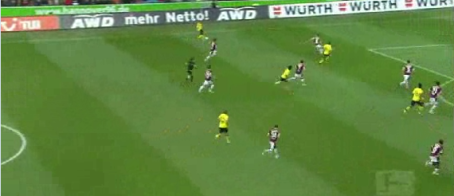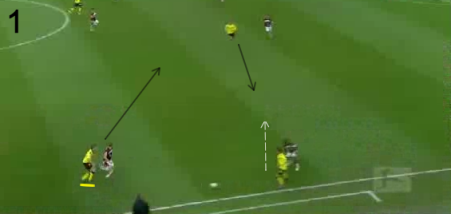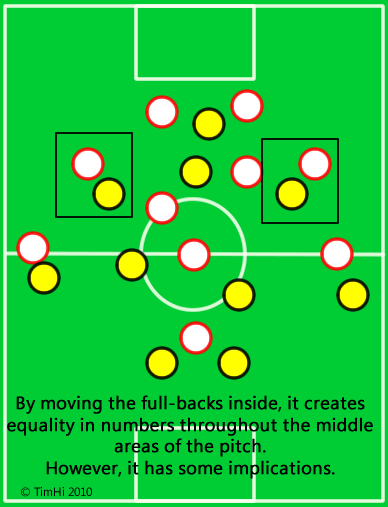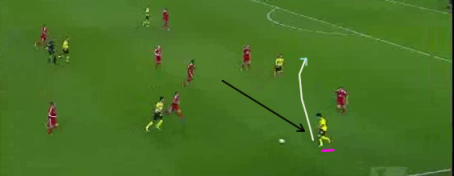Jurgen Klopp, sitting on the proverbial throne placed on the zenith of Die Südtribüne, has earned his position of Dortmund royalty this season.
His tenderfoot squad has exceeded expectations, and after thirteen games lead the ‘World’s Best League™’ by seven points. The path to seniority in the Bundesliga has not been through attritional, grinding football, but with an expansive and unrepressed style.
The numbers are impressive, they’ve scored the most (31), five more than any other team in the division and have conceded the least (8), six less than their competitors. But we don’t do things by numbers here (apart from painting, naturally), and this startling improvement surely needs to be legitimised through analysis.
Klopp’s men have handed a through old-fashioned thrashings to a few teams this season. A particular esteemed walloping came at the Hannover after Mirko Slomka’s troops bent over and let Dortmund hand them a kind of spanking once commonplace in Victorian Britain.
It’s easy to understand why Dortmund are top; with an attack as smooth and anointed as a Catholic Priest and a defence as tight and cramped as a Nun’s ‘passage’ – it is as deadly as it is tempting, combination.
The first observation is that all the width comes through the full-backs. The midfield stays tight, narrow and thoroughly impenetratable.
When they push forward, the front trio, instead of staying wide and looking for full-backs to cut inside – prefer to push forward and join the lone forward, Lucas Barrios. It says a lot that previous Hertha BSC winger Łukasz Piszczek is now being played in a full-back role – illustrating Dortmund’s attacking tenets this year.
From an attacking sense, they’re incredibly dangerous. Klopp has unbelievably integrated a physical skill set with a technical proficiency that is only seen in the top European clubs.
Pardon my expressions, but this Dortmund has in its cupboard all the ingredients needed by a modern team to be successful in the long-term. It has a young, talented batch of German players with a dash of elan and chic discovered in foreign lands.
Put simply, the team is chocker block full of players who are technically able, confident and always looking to receive the ball at feet. What are the implications of such positive attitudes? Well, it permits Dortmund to play in tight, narrow areas, without worrying about losing possession.
Their five-some in midfield are capable from passing from deeper positions as well as dropping deep to pick up the ball. This allows them to transfer from defence into attack within seconds, something that less technically proficient sides really struggle to do.

Dortmund's technical midfield allows them to move the ball with one or two touches, allowing them to exploit poor defensive positioning
Their narrow midfield has another important function too – winning the ball back. By playing with a very compact midfield and defence, with hardly any spaces between them, the Dortmund defence are great at pushing players into the unyielding arms of the Dortmund midfield. This makes it very hard for teams to penetrate Dortmund through the middle, as their defence are not afraid to move forward and chase opposition forwards into their own half.
Subotic and Hummels are both only twenty-one – the youngest defence pairing in the Bundesliga – and have taken to Klopp’s high-line and pressing defensive philosophy like that proverbial duck to water. Subotic may not be the most mobile of defenders, but Mats Hummels has the speed to cover for him if he’s moved too far out of position.
The pressing usually starts when the ball moves into the midfield or out-wide to the full-backs, however Kagawa and Barrios like to step forward and stop the easy ball in to the midfield, all the whilst Sahin and Bender are sitting off the central midfielders, ready to pounce if the ball moves to them. Mario Götze and Kevin Großkreutz attempt to stop the ball moving to the full-backs – making it difficult for the opposition to really start moves off.

Kagawa and Barrios stop easy balls in to midfield. Sahin and Bender look to drop a few yards deep from midfield to intercept passes.
An obvious response to this is to by-pass the midfield, which was seen when Freiburg playing Dortmund last weekend. Freiburg were quite unlucky to lose 2-1, and Freiburg did well to contain Dortmund until a ten minute period in the second-half. Their gameplan consisted of using Papiss Cissé’s strength and ability (must refrain from using ‘good touch for a big man’) to move the ball forward quickly. Freiburg’s narrow five-man midfield looked to offer support for Cissé – and it worked for the best part of 90 minutes.
Łukasz Piszczek: a copy & paste name if I’ve ever seen one
Łukasz Piszczek is an interesting proposition at right-back. Used primarily as a winger at Hertha Berlin for a long period of time, he’s successfully transformed himself into a competent right-back. He’s used very well at Dortmund his attacking forays into the attacking third are something to keep your eye on – in particular, his movement in-field was something that was extremely common – or, for its correct terminology – ‘something straight off the training ground.’
Łukasz Piszczek starts the move, moving the ball to Mario Götze, who places himself on the sideline; dragging the full-back forward and wide.
Kagawa follows the movement and drops deep, moving the centre-back out with him, creating a Piszczek-sized gap for him to run into when Kagawa moves the ball to him.
Often you see full-backs exploiting the space in wider positions and behind the full-backs, it’s rather novel seeing a full-back cutting inside and finding himself with shooting opportunities. As with the Portuguese international, Fábio Coentrão, Łukasz Piszczek finds himself as a winger being used well in a deeper position.
The attacking intent shown by Łukasz Piszczek has its downfalls, with Dortmund’s defence finding themselves sometimes rather stretched, with the space between centre-backs being large enough for even the most monolithic of strikers to move into.
Nuri Sahin: a left-foot crafted in the womb of Virgin Mary, made specifically for Dortmund
The German-born Turkish midfielder is the creator and provider of all things beautiful for this Dortmund side. Against Hannover and HSV his one-touch passing and movement allowed Dortmund to move the ball quickly and into dangerous spaces whilst his piercing longer passes often dissected the cumbersome Hannover defence. In this video, the first two goals illustrate how Sahin is able to place the ball exactly where his teammates want it. Due to the way Dortmund play, in intricate, tight arenas, Sahin’s precision with the ball is fundamental to the success of this team.
From a tactical point of view, the narrow attacking midfielders create migraine-sized headaches for the opposition.
Götze & Großkreutz: Two Double G’s that have nothing to do with Hip-Hop
As mentioned, Mario Götze and Kevin Großkreutz rarely stay on the sidelines, preferring to find pockets of space between midfield and defence in central areas. Kagawa, put simply, just moves.
However, it’s the two German youngsters that provide difficulties for the opposition.
They operate in areas where there is not a direct opposition player designated to combat their effectiveness. Although ‘in the hole’ players may now be meeting their match with the increasing importance of defensive midfielders, players who operate in the channels and deeper can be now seen with relatively the same importance.
Why are Götze and Großkreutz effective this season? Well, it forces the opposition to make a decision on who is going to pick them up.
If they leave them in the realm of central midfielders responsibility, they’ll be outnumbered unless they play with two or three deep central midfielders; this also leaves the full-backs as largely redundant.
If the opposition instruct their full-back to pick them up, it allows them to have a spare man in the middle of the park to close down whoever the manager instructs or to sit and be used as a spare man. Dortmund, however, have options to rebuff this tactical repositioning.
The problem is Kagawa is a clever little player. He knows when to move wide to drag players with him, creating space for Götze or Großkreutz to play with. Kagawa has a very Ozil-esque left-foot, which is able to design and create a first-time ball through a defence from wider areas of the pitch.
The attacking quartet (+Piszczek) is able to create sparkling football at times; their movement quick and incisive, only matched by their penetrative passing and two-touch football. Klopp has them organised in such a way that they can respond to the opposition’s organisation as well as being hard to play against. Their youth allows them to press for seventy minutes without changes, and, by that time, the game is usually over. Teams without a clear game-plan or midfield players capable of handling the tenacity of the ‘Die Borussen’ will struggle to play through the middle of the park.
It’s not that the quartet has technical ability; they have power and pace and the ability to cut-through a defensive line with one run. Their right-side is always dangerous, with the pacey Jakub Błaszczykowski often coming off the bench to replace Mario Götze.
It’s easy to understand why out of all the top leagues in Europe that Dortmund have scored the third most (after Real Madrid & Barcelona, respectively) and have conceded the same amount as Barcelona (even if they don’t dominate games as much as the Catalan giants do). Jurgen Klopp has concocted a delicious mix of technical adroitness and physical accomplishment to propel his Dortmund team to the top of the Bundesliga after 13 games.
Bespectacled Jurgen Klopp is animated on the pitch, never giving the fourth official, his face – or anything else for that matter – a moments rest. His energy and youthful exuberance has been disseminated throughout his team – from the defence to the attack, Dortmund are spasmodic, yet paradoxically, have a fluidity of a team who have been playing together for years.
We may just be looking at the Bundesliga champions this year…
Łukasz Piszczek is an interesting proposition at right-back. Used primarily as a winger at Hertha Berlin for a long period of time, he’s successfully transformed himself into a competent right-back. He’s used very well at Dortmund his attacking forays into the attacking third are something to keep your eye on – in particular, his movement in-field was something that was extremely common – or, for its correct terminology – ‘something straight off the training ground.’














Keine Kommentare:
Kommentar veröffentlichen